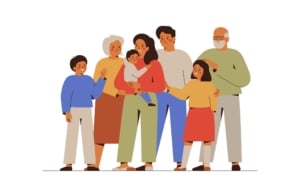Marketing to Seniors and Adult Kids? Start Here.
During a panel discussion at the 2025 Aline Innovation Summit, one statistic in particular caught our attention: while 55% of adult children cite safety as their top motivator for researching senior living, only 12% of older adults share the same sentiment.
That’s a striking disconnect and a reminder that what motivates an adult child is quite different from what motivates a future resident.
And yet, there’s one thing both audiences agree on: having a clearer picture of life in the community would make the decision easier (55% of older adults and 56% of adult children, according to Aline’s data).
So how do you speak to two vastly different personas at the same time? How do you market to one, nurture the other, and ultimately bring them both to a confident yes? That’s where segmentation, smart messaging, and marketing automation come into play.
Let’s dive into each below.
Step #1: Segment by persona.
If you want your senior living marketing and sales efforts to pay off, you have to start with one fundamental shift: Stop treating all prospects the same.
That means moving beyond the generic “Contact Us” approach and getting intentional about segmenting your audiences into two primary groups:
- Older adult/future resident
- Adult child/influencer
On your contact form, encourage people to self-identify. You can accomplish this through a simple statement that requires people to categorize themselves:
I’m researching senior living on behalf of . . .
- Myself
- Myself and my spouse/partner
- My spouse
- My mother
- My father
- Another family member
On the marketing side, the person’s selection is what triggers the segmentation. The first three options indicate an older adult/future resident. The other three options indicate an adult child/caregiver.

Marketing automation platforms like HubSpot can automatically sort contacts into segmented lists based on that answer. Instead of just collecting name and contact info, you’ll know which journey the person is on.
On the sales side, it’s about building the right profiles. Every sales opportunity should be created with two contacts in mind:
- The prospect (the older adult)
- The influencer (typically the adult child)
When your CRM and marketing automation platform are connected bi-directionally, you can sync this information in real time.
Now, your marketing team can launch targeted nurture campaigns, and your sales team can track engagement and pick up the conversation exactly where the automation left off.
Bottom line: Proper segmentation is the critical first step in making sure the right message reaches the right prospect at the right time. Without segmentation, you might end up sending multiple messages about safety to everyone. Sure, that messaging might resonate with the adult child. But it might also cause the older adult to start looking elsewhere since they care more about other things.
Step #2: Speak their language.
Once you’ve segmented your site visitors into the right personas, the next step is to tailor your messaging to match their motivations. Remember, a one-size-fits-all message won’t work when your personas are coming from such different places.
For the adult child/influencer, the messaging should focus on peace of mind.
As the Aline data suggested, adult kids are often worried about safety, health concerns, and the growing complexity of caregiving. They want to know their loved one will be safe, supported, and well cared for.

So, for example, your safety messaging could include developing content around . . .
- 24/7 staffing. Don’t just state it. SHOW it. Spotlight staff members who work the overnight shift, for example.
- Emergency call systems and fall prevention technology. Talk up the technology you use and why you chose it. Show how it works.
- EXAMPLE: One of our SLS team members recalls touring a senior living community with detached homes, where all residents had to push a button by a specific time each morning to signal they were awake and doing well. (Think of a cute video you could make around that!)
- Overall security around the community’s grounds: Consider lighting, alarms, and other security measures.
- Reviews that highlight safety wins. Monitor your Google reviews for those that mention safety concerns.
- PRO TIP: This could be an excellent task for an AI agent, like ChatGPT Agent. The agent can monitor for new reviews about safety and alert you when one is published. Then, you can use these fresh reviews across social media, in lead nurturing emails, and on key website pages.
For the older adult/future resident, the messaging should feel more aspirational.
As the Aline data suggests, older adults are curious about what life might look like if they lived in your community. For example, they might be eager to know that they can maintain independence, enjoy flexibility, and continue living life on their own terms.
Messaging that resonates with this group includes:
- “A day in the life” stories and videos (this will also resonate with the adult child)
- Resident testimonials that focus on lifestyle and autonomy
- Opportunities to make new friends and try new things
- Dining programs, happy hours, outings, and self-care options
- Beautiful apartments and vibrant common spaces
This persona needs to see what’s possible. They’re not looking for care; they’re looking for community.
Bottom line: Segmenting your audiences doesn’t mean diddly-squat if you don’t take the time to create custom messaging that resonates with each persona.

Step #3: Create campaigns for every stage.
Not every lead is ready for a tour tomorrow, and that’s OK. The key is making sure you’re meeting future residents and adult children where they are in their respective journeys.
This is where automated campaigns shine. But not just any campaigns. You need a mix of touchpoints designed for each persona and each stage of the decision-making process.
Here’s a breakdown of some of the campaign types we build at SLS:
- Welcome campaigns. The goal here is to make sure that every lead is acknowledged and nurtured immediately, even outside of business hours.
- Speed to the Lead campaigns. These are built specifically for leads that come in from third-party aggregators, where a fast response can make or break the opportunity. (And by fast, we mean minutes, not hours.)
- “Still Thinking?” campaigns. You need a plan to re-engage leads that have stalled in the pre-tour stage. They’re often still evaluating their options, and a little nudge can make all the difference.
- “What Are You Waiting For?” campaigns. This campaign is for people who stall after they’ve toured. The goal is to get them back on track and move them closer to a decision.
- Stay in Touch campaigns. We use this campaign (to great success) to revive cold leads and spark new interest with updated content, recent event photos, or stories from current residents.
You can (and should) also build persona- and care-level-specific campaigns. The experience should feel tailored, whether you’re talking to:
- An adult daughter looking into memory care for her father
- A couple considering independent living for themselves
- A son exploring assisted living options for his mom
Each of these journeys is different. Your content and tone should reflect that.
Bottom line: A single drip campaign won’t cut it. You need a campaign ecosystem that speaks to who the person is, what they’re looking for, and where they are in their journey. When you get this right, your messaging feels less like marketing and more like a helpful guide along the way.

Step #4: Support with smart content and tools
Strengthen your campaigns with the right mix of content, touchpoints, and tools. This is where you turn your segmented strategy into a fully personalized experience that feels useful, timely, and human.
Here are some of the ways we support campaigns at SLS:
- Well-crafted email messaging. Not too long, not too salesy, and never generic. Each email should speak directly to the prospect’s situation and mindset. (And yes, this means writing different email workflows for each persona.)
- SMS touchpoints. Text messaging can be an effective and respectful way to follow up, especially with adult children who are busy juggling jobs, caregiving, and other responsibilities. The key is to be helpful, not intrusive.
- Premium content. Think downloadable guides, eBooks, interactive videos, checklists, and short quizzes. These resources help educate prospects and build trust. They’re also great for surfacing intent and moving people further down the funnel.
- Interactive tools. Tools like Roobrik and Money Gauge are incredibly effective at teasing out a lead’s mindset. Are they overwhelmed? Are they ready to move soon? What are they most concerned about? Cost? Care? Lifestyle? These tools gather insights while also providing value to the user.
The best part? When integrated with your marketing automation platform, these tools can automatically update the prospect’s profile and trigger the right next step in their journey—no manual effort required.
Bottom line: The tools and tech only work if the content behind them is strong. Invest in making every email, video, guide, and touchpoint feel relevant and human. That’s how you build trust and move people forward.
Bridging the motivation gap between adult children and older adults is essential for effective senior living marketing and sales.
With precise segmentation, targeted messaging, personalized campaigns, and smart tools, you can meet both audiences where they are and guide them forward with clarity and confidence.
Need help? Get in touch with our senior living marketing team.






